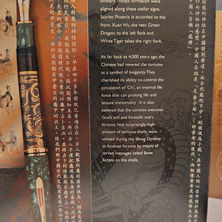top of page
Pelikan Xuan Wu (2001) - Asia Limited Edition
The fourth release of the Asia Limited Edition was the Xuan Wu (2001), based on the motif of Xuanwu.
According to ancient Chinese mythology, there are guardian deities in the four directions in the sky, and all creatures are said to belong to each guardian deity according to their nature and characteristics. The guardian deities of the four directions are called the "Four Gods": the Dragon in the East, the Tiger in the West, the Phoenix in the South, and Xuanwu in the North⁽¹⁾.
In Chinese astronomy, Xuanwu is in the Seven Northern Mansions: one of the four divisions of the sky along the equatorial belt of the sky. The shapes of the Seven Northern Mansions were linked together to form a turtle with a snake entangled in it.
Xuanwu is written as "玄武" in Chinese characters. ”玄"(Xuan) means black, and black is the color of the north in the Five Element Theory, representing water. So, Xuanwu is the water god who protects the north. As stated above, the figure of Xuanwu takes the form of a combined turtle-snake statue. Sometimes, the long-legged turtle is depicted with a snake wrapping around it.
In ancient China, the tortoise symbolized "longevity and immortality" and the snake symbolized "reproduction and fertility". The combination of tortoise and snake in Xuanwu is compared to the combination of Yin and Yang: Xuanwu or the tortoise and snake live together, and they become a male and female, then a mate.
The original spelling of "Xuanwu" was "玄冥”(Xuanming) ("冥" means "yin") and Xuanwu was thus considered a "moon deity", and it was believed that Xuanwu could travel between the underworld (in the north) and the present world, receive oracles (of turtle divination) in the underworld, and bring the answers back to the present world.
The "武”(Wu) means "the art of war; martial arts; military arts", and "wu" in "Xuanwu" comes from Xuanwu's divinity as a "warrior god. According to Chinese literature, "Xuanwu is the chief of crustaceans", and "Xuanwu has scales and a shell on his body, hence the name is Wu." Xuanwu is said to be brave and skilled in martial arts, to travel between heaven and earth, to be praised by all spirits, to slay demons, to ward off evil, and to bring health, peace, and a clean home to good people.
Unlike Dragon, Phoenix, and White tiger, there is no animal corresponding to Xuanwu in the West, and Xuanwu may not be familiar to Westerners, but in China and Japan, it has been an object of worship since ancient times.
Like the White Tiger, this fountain pen is made of a beautiful green marble-colored resin, reminiscent of jade, rather than a single color. Considering the origin of Xuanwu, it should originally have been black, but black had been adopted for the Golden Dynasty, so this color would have been chosen. The nib shape and font have changed slightly since the Xuan Wu, and the “PF” mark is no longer present (Fig.3-3).
The packaging has changed again from the Xuan Wu. The inner box is now made of wood again, but it is one size larger than the White Tiger. The inner box has the word “玄武” and the Xuanwu depicting the long-legged turtle with a snake wrapping around it, engraved on the lid (Fig.2-2). The Xuanwu design is different from that on the sleeve of the pen. The wooden box has a magnet to prevent the box from opening accidentally (Fig.2-3). It now comes with a cloth bag to wrap the inner box. The outer box that holds the inner box is again made of paper and is almost the same size as the inner box.
Note;⁽¹⁾ On a personal note, when I hear the name "Xuanwu", I immediately think of the "Xuanwu Gate Incident" (玄武門之変) in Tang dynasty, China. The Xuanwu Gate Incident was a palace coup for the throne of the Tang dynasty on 2 July 626, when Prince Li Shimin (李世民) (Prince of Qin) and his followers assassinated his brothers Crown Prince Li Jiancheng (李建成) and Prince Li Yuanji (李元吉) (Prince of Qi). Li Shimin, the second son of Emperor Gaozu (唐高祖), was in an intense rivalry with his brothers. He took control and set up an ambush at the Xuanwu Gate, the northern gate leading to the Palace City within the imperial capital Chang'an. There, Li Jiancheng and Li Yuanji were murdered by Li Shimin and his men. Within three days after the coup, Li Shimin was installed as the crown prince. About two months later, Emperor Gaozu abdicated and passed the throne to Li Shimin, who would become known as Emperor Taizong (唐太宗). This is probably one of the most dramatic political changes in Chinese history.
Xuan Wu
My collection.
bottom of page















